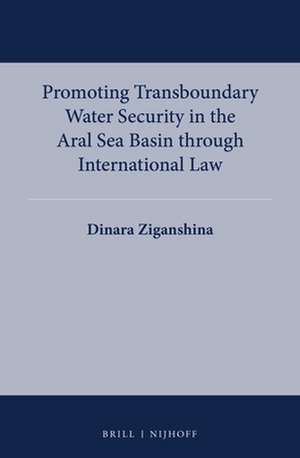Promoting Transboundary Water Security in the Aral Sea Basin through International Law: International Water Law Series, cartea 3
Autor Dinara Ziganshinaen Limba Engleză Hardback – 12 oct 2014
Preț: 652.55 lei
Preț vechi: 795.80 lei
-18% Nou
Puncte Express: 979
Preț estimativ în valută:
124.88€ • 129.90$ • 103.10£
124.88€ • 129.90$ • 103.10£
Carte indisponibilă temporar
Doresc să fiu notificat când acest titlu va fi disponibil:
Se trimite...
Preluare comenzi: 021 569.72.76
Specificații
ISBN-13: 9789004274235
ISBN-10: 9004274235
Pagini: 254
Dimensiuni: 155 x 235 x 20 mm
Greutate: 0.61 kg
Editura: Brill
Colecția Brill | Nijhoff
Seria International Water Law Series
ISBN-10: 9004274235
Pagini: 254
Dimensiuni: 155 x 235 x 20 mm
Greutate: 0.61 kg
Editura: Brill
Colecția Brill | Nijhoff
Seria International Water Law Series
Cuprins
Introduction
1.1.Problematique and research question
1.2.Contribution to existing research
1.3.Methodology and outline of the book
Part One: A Conceptual and Analytical Framework
Chapter 2. Understanding International Law: A Conceptual and Analytical Framework
2.1. International law: Norms, behaviour, consciousness
2.1.1.Normative facet: Legal norms
2.1.2.Sociological facet: Legally relevant behaviour
2.1.3.Psychological facet: Legal consciousness
2.1.4.Legal relationships within normative communities
2.2. Analytical framework: Properties of norms and processes
2.2.1.Norm properties: Determinacy and stringency
2.2.2.Process properties: Inclusiveness, transparency, discursiveness and coherence
Conclusion
Part Two: Understanding International Water Law in the Aral Sea Basin
Chapter 3. Setting the Scene: the Aral Sea Basin
3.1.Transboundary waters of the Aral Sea basin: Challenges and opportunities
3.1.1Physical characteristics of the basin
3.1.2Socio-economic uses and environmental concerns
3.2.Legal instruments that govern transboundary waters in the Aral Sea basin
3.2.1Treaties at sub-regional level
3.2.2Treaties at regional and global levels
Chapter 4. Scope and Substantive Norms in the Aral Sea Basin: Norm Properties
4.1.Scope
4.2.Substantive norms
4.2.1.The principle of equitable and reasonable use
4.2.2.The no-harm rule
4.2.3.Obligations related to environmental protection
4.3.Substantive norms within a system of international water law
Chapter 5. Procedural System of Transboundary Water Cooperation in the Aral Sea Basin: Norm Properties
5.1Cooperation through joint bodies
5.2Regular information exchange and consultations
5.3Prior notification on planned measures and other related obligations
5.4Transboundary impact assessment
5.5Emergency cooperation
5.6Compliance review
5.7Dispute settlement
Conclusion
Chapter 6. International Water Law in the Aral Sea Basin: Process Properties
6.1.Inclusiveness
6.2.Transparency
6.3.Discursiveness
6.4.Coherence
Conclusion
Chapter 7. Making Use of the International Water Law in the Aral Sea Basin and Beyond: Main Findings, Recommendations, and Broader Implications
7.1.International water law in the Aral Sea basin: Main findings and recommendations
7.1.1.Improve treaty system in a multilevel governance context
7.1.2.Enable the dual role of legal norms for stability and peaceful change
7.1.3.Make process matter
7.1.4.Catalyse actors
7.1.5.Enhance legal consciousness
7.1.6.Increase transparency and strengthen linkages
7.1.7.Transform intergovernmental bargaining into deliberative problem solving
7.1.8.Build normative communities
7.2.Making use of international (water) law: Broader implications and areas for future research
Conclusions
1.1.Problematique and research question
1.2.Contribution to existing research
1.3.Methodology and outline of the book
Part One: A Conceptual and Analytical Framework
Chapter 2. Understanding International Law: A Conceptual and Analytical Framework
2.1. International law: Norms, behaviour, consciousness
2.1.1.Normative facet: Legal norms
2.1.2.Sociological facet: Legally relevant behaviour
2.1.3.Psychological facet: Legal consciousness
2.1.4.Legal relationships within normative communities
2.2. Analytical framework: Properties of norms and processes
2.2.1.Norm properties: Determinacy and stringency
2.2.2.Process properties: Inclusiveness, transparency, discursiveness and coherence
Conclusion
Part Two: Understanding International Water Law in the Aral Sea Basin
Chapter 3. Setting the Scene: the Aral Sea Basin
3.1.Transboundary waters of the Aral Sea basin: Challenges and opportunities
3.1.1Physical characteristics of the basin
3.1.2Socio-economic uses and environmental concerns
3.2.Legal instruments that govern transboundary waters in the Aral Sea basin
3.2.1Treaties at sub-regional level
3.2.2Treaties at regional and global levels
Chapter 4. Scope and Substantive Norms in the Aral Sea Basin: Norm Properties
4.1.Scope
4.2.Substantive norms
4.2.1.The principle of equitable and reasonable use
4.2.2.The no-harm rule
4.2.3.Obligations related to environmental protection
4.3.Substantive norms within a system of international water law
Chapter 5. Procedural System of Transboundary Water Cooperation in the Aral Sea Basin: Norm Properties
5.1Cooperation through joint bodies
5.2Regular information exchange and consultations
5.3Prior notification on planned measures and other related obligations
5.4Transboundary impact assessment
5.5Emergency cooperation
5.6Compliance review
5.7Dispute settlement
Conclusion
Chapter 6. International Water Law in the Aral Sea Basin: Process Properties
6.1.Inclusiveness
6.2.Transparency
6.3.Discursiveness
6.4.Coherence
Conclusion
Chapter 7. Making Use of the International Water Law in the Aral Sea Basin and Beyond: Main Findings, Recommendations, and Broader Implications
7.1.International water law in the Aral Sea basin: Main findings and recommendations
7.1.1.Improve treaty system in a multilevel governance context
7.1.2.Enable the dual role of legal norms for stability and peaceful change
7.1.3.Make process matter
7.1.4.Catalyse actors
7.1.5.Enhance legal consciousness
7.1.6.Increase transparency and strengthen linkages
7.1.7.Transform intergovernmental bargaining into deliberative problem solving
7.1.8.Build normative communities
7.2.Making use of international (water) law: Broader implications and areas for future research
Conclusions
Notă biografică
Dr. Dinara Ziganshina is a Deputy Director of the Scientific Information Center of Interstate Commission for Water Coordination in Central Asia, based in Tashkent, Uzbekistan.









